The increased emphasis on making quality silage has driven exponential growth in sales of rakes and tedders. This has particularly been the case over the past decade, and more so in recent years with tedders.
Based near the town of St Mullins which straddles the Carlow-Wexford border, dairy farmer John Doyle recognised the benefits of tedding in the mid-noughties, acquiring his first tedder in 2004. Having been working full-time with a contractor for some years, John returned home to full-time dairy farming in 2008.
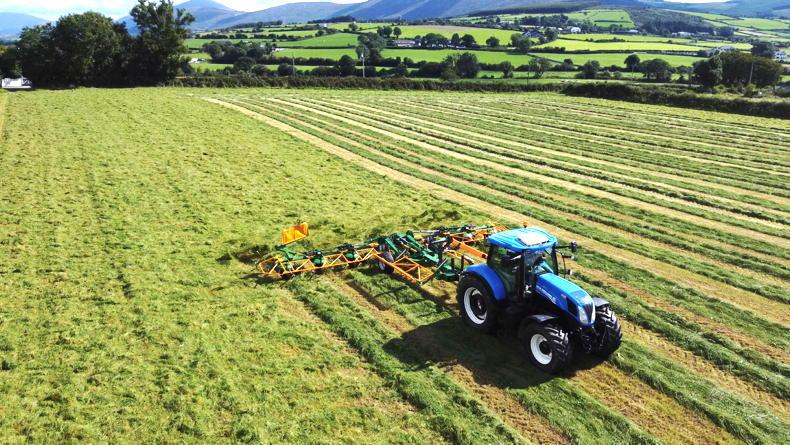
Building on the launch of its first trailed tedder in 2022, the eight-rotor is Malone's flagship tedder offering and is known as the Tedd-air 1128T.
“We milk 80 British Friesian and Fleckvieh-type cows in a spring-calving operation.
“When I decided to return home to full-time farming, Michael Ryan and Son Agricultural Contractors – who run a large contracting outfit – asked me would I be interested in carrying out the tedding work for them. I decided to take it on as it would help to supplement the farm income and it suited during the summer months when much of the heavy farm work would be completed,” explained John.
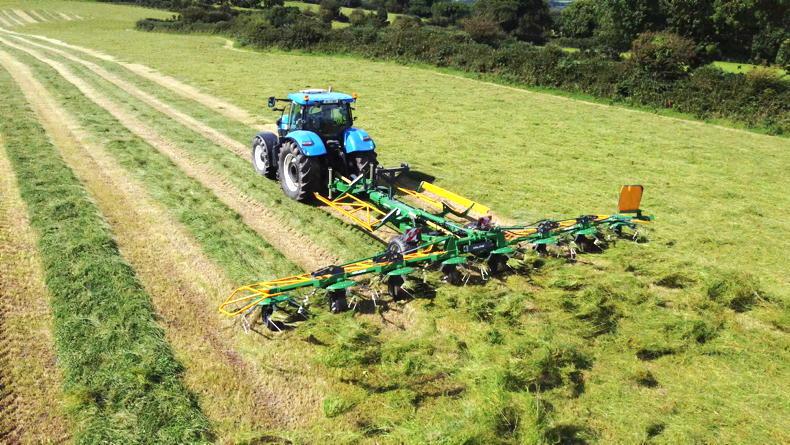
The tedder is coupled to the tractor by a two-point linkage headstock, while Malone are using Walterscheid PTO shafts and Comer gearboxes.
“I decided to buy a new Lely 770 six-rotor mounted tedder in 2008 to take on the hire work. We had previously been using a Lely 660 six-rotor tedder on our farm four or five years prior to that, which was a secondhand machine that we picked up.
“I decided to go Lely the second time around again as the first machine we had seemed to be reliable,” he recalled.
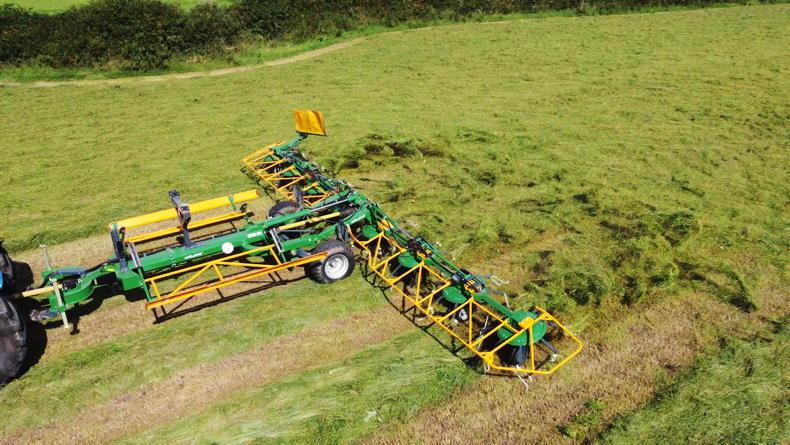
The tedder is fitted with 1.6m diameter rotors that are equipped with seven tine arms that feature a double hooked tine.
“In the early years, the tedding workload wasn’t overly busy. I ran the Lely 770 right the way up to 2019. The Lely was a good machine, but it really struggled on rougher ground and did give some trouble.
“We looked at the market and I felt that the Malone tedder seemed like the best machine out there. I always had a liking for the hooked tine, and this was a deciding factor in buying the new Malone six-rotor mounted tedder in 2019.
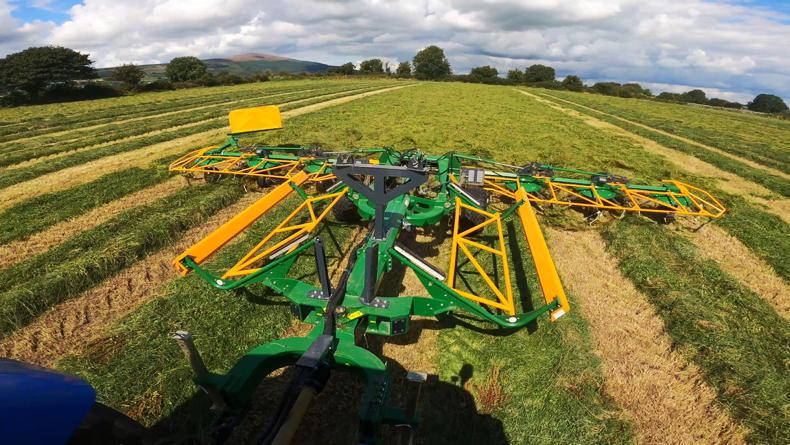
Weighing in at 2,860kg, it requires two double acting hydraulic connections to be operated.
“By 2021, the workload was growing each year. I decided that I was going to have to run a second fresh machine to keep up with the demand and the short weather windows.
“A local dealer had a new Pöttinger eight-rotor tedder in stock.
“For an eight-rotor mounted machine, it was very compact. I got a good deal at the time and I decided to buy it. I kept it for two seasons, but I wasn’t overly happy with it. I felt that it struggled to deal with the heavy swarths. I often used to meet the lads from Malone at shows and before the 2023 season, we did a deal on a new eight-rotor trailed tedder,” said John.

"I’ve tried it up and down and I’ve found that running it at 540rpm at a forward speed of 7.5-8km/h is the sweet spot," said John.
Malone Tedd-air 1128T
Malone Farm Machinery only officially launched its new eight-rotor trailed tedder at Agritechnica in Germany in November last year, but John purchased a pre-production model at the beginning of the year. This was also the first eight-rotor machine the company manufactured.
Building on the launch of its first trailed tedder in 2022, the eight-rotor is Malone’s flagship tedder offering and is known as the Tedd-air 1128T. As the name suggests, it has a working width of 11.2m (36ft).
The Mayo manufacturer first launched its tedder range in late 2015 and, since then, has stuck with the double hook tine design, with this machine being no different.
The tedder is coupled to the tractor by a two-point linkage headstock, while Malone is using Walterscheid PTO shafts and Comer gearboxes.
When it comes to tedding out the headland swarth, a curtain is hydraulically lowered to deflect the crop away from the edge of the field. The tedder is fitted with 1.6m diameter rotors that are equipped with seven tine arms that feature a double hooked tine. The angle and height of the rotors can be adjusted.
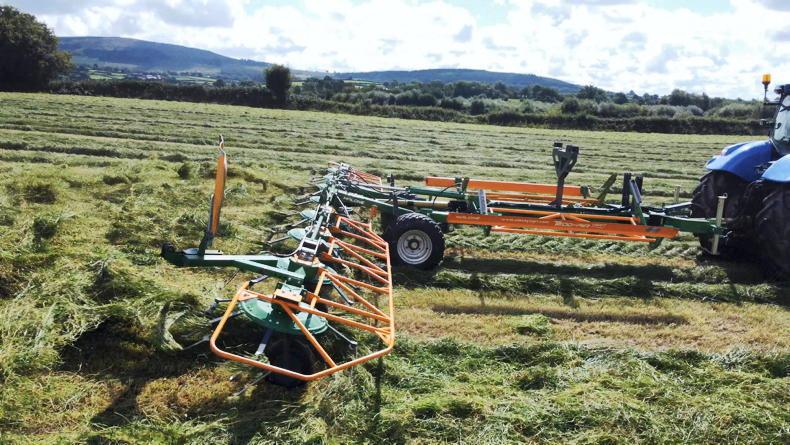
"If I went into a 40ac field, I’d have it tedded in two hours. In smaller fields, output would probably be in the region of 13/14 acres an hour”, added John.
With a folded transport length of 5.6m, the unit has a transport width of 2.9m and a transport height of 2.9m.
Weighing in at 2,860kg, it requires two double-acting hydraulic connections to be operated.
One folds the linkages in and out, while a diverter switch allows the same spool valve to control the hydraulic curtain for tedding on the headlands. The second double-acting spool drops the linkage arms into the transport position.
Other features include Kennfixx hydraulic connections, a spare wheel and an LED lighting kit.
“Tedding is a funny job, and the amount of work you do all depends on the weather.
“On average, I am tedding in the region of 3,000 to 4,000 acres each year across silage, hay and straw.
“The big thing for me is that I don’t want to hold up silage harvesters or balers by doing bad work, most notably leaving grass in lumps behind. With the eight-rotor tedder, I’ve tried it up and down and I’ve found that running it at 540rpm at a forward speed of 7.5-8km/h is the sweet spot.
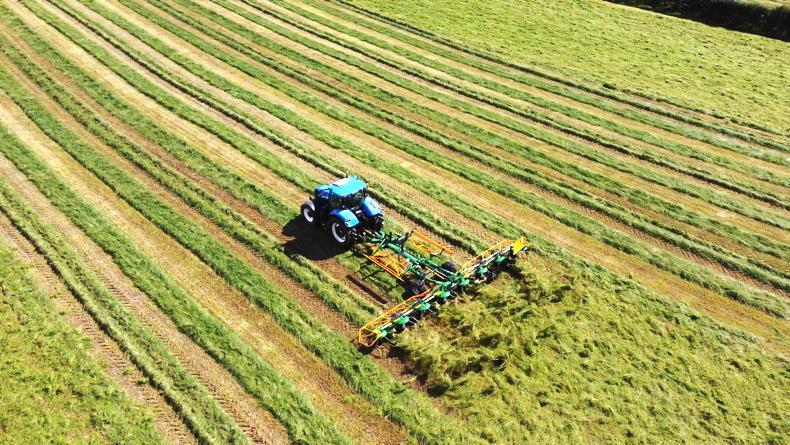
“Tedding is a funny job, and the amount of work you do all depends on the weather. On average, I am tedding in the region of 3,000 to 4,000 acres each year across silage, hay and straw."
“Output all depends on the fields. If I went into a 40ac field, I’d have it tedded in two hours. In smaller fields, output would probably be in the region of 13 or 14 acres an hour,” said John. 
Weighing in at 2,860kg, it requires two double acting hydraulic connections to be operated.
“Although it’s long, the trailed machine is very easy to manoeuvre. It’s not on a steering axle but it pivots at around 2ft or 2.5ft behind the lift arms, in a similar way to a large disc harrow or a trailed drill.
“The six-rotor mounted is very high, and it is wide at the cab level on the third and fourth rotors with a fair tail swing.
“The trailed is much steadier on the road, and you’ve better visibility to the rear with it on the road,” said John.
First choice
“The trailed machine is definitely my first choice, it probably did 80% of my hire work last year. I run the trailed tedder on a New Holland T7.210, but I also ran it on my New Holland TM120 and it operated it no problem,” he outlined. 
"I’ve tried it up and down and I’ve found that running it at 540rpm at a forward speed of 7.5-8km/h is the sweet spot," said John.
“I am very happy with the Malone tedders. They are well-built, and have been practically maintenance-free. With the exception of a handful of tines, the Malone tedders have given us no mechanical trouble whatsoever.
“You would adjust the working height of the rotors in a few minutes, and the rotors lift to offer over 2ft of clearance while working in the field.
“The big thing for me is the work they do. When operated correctly, they simply just don’t lump the grass.
“We have tried out and gone to see almost all makes and brands of tedders working, and my opinion is that all tedders work fine in lighter swarths of grass, but the Malone is the only machine to handle heavy swarths. I can’t see myself moving away from them,” concluded John.
Likes
Does excellent work and leaves no lumps.Built very strong.Has huge output capacity. Model: Tedd-air 1128T.Working width: 11.2m (36ft).Rotors: 1.6m diameter (seven tines per rotor). Tine type: double hook tine. Weight: 2,860kg.Transport length: 5.6m.Transport width: 2.9m.Transport height: 2.9m.Price: €29,500 plus VAT.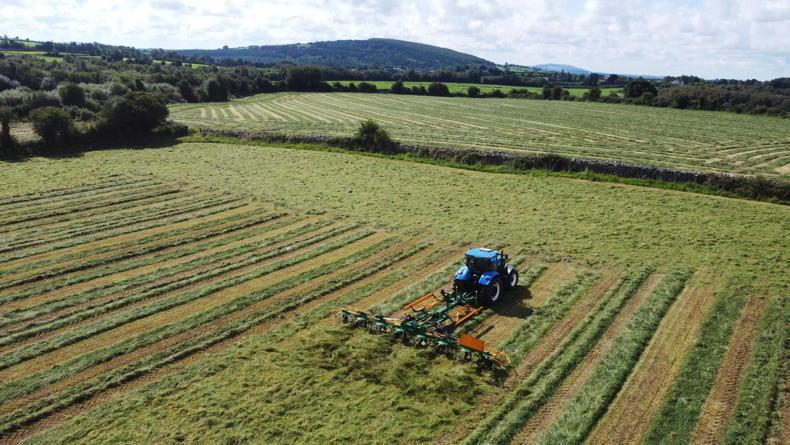
‘In my opinion, all tedders work fine in lighter swarths of grass, but the Malone is the only machine to handle heavy swarths,’ John said.
The increased emphasis on making quality silage has driven exponential growth in sales of rakes and tedders. This has particularly been the case over the past decade, and more so in recent years with tedders.
Based near the town of St Mullins which straddles the Carlow-Wexford border, dairy farmer John Doyle recognised the benefits of tedding in the mid-noughties, acquiring his first tedder in 2004. Having been working full-time with a contractor for some years, John returned home to full-time dairy farming in 2008.

Building on the launch of its first trailed tedder in 2022, the eight-rotor is Malone's flagship tedder offering and is known as the Tedd-air 1128T.
“We milk 80 British Friesian and Fleckvieh-type cows in a spring-calving operation.
“When I decided to return home to full-time farming, Michael Ryan and Son Agricultural Contractors – who run a large contracting outfit – asked me would I be interested in carrying out the tedding work for them. I decided to take it on as it would help to supplement the farm income and it suited during the summer months when much of the heavy farm work would be completed,” explained John.

The tedder is coupled to the tractor by a two-point linkage headstock, while Malone are using Walterscheid PTO shafts and Comer gearboxes.
“I decided to buy a new Lely 770 six-rotor mounted tedder in 2008 to take on the hire work. We had previously been using a Lely 660 six-rotor tedder on our farm four or five years prior to that, which was a secondhand machine that we picked up.
“I decided to go Lely the second time around again as the first machine we had seemed to be reliable,” he recalled.

The tedder is fitted with 1.6m diameter rotors that are equipped with seven tine arms that feature a double hooked tine.
“In the early years, the tedding workload wasn’t overly busy. I ran the Lely 770 right the way up to 2019. The Lely was a good machine, but it really struggled on rougher ground and did give some trouble.
“We looked at the market and I felt that the Malone tedder seemed like the best machine out there. I always had a liking for the hooked tine, and this was a deciding factor in buying the new Malone six-rotor mounted tedder in 2019.

Weighing in at 2,860kg, it requires two double acting hydraulic connections to be operated.
“By 2021, the workload was growing each year. I decided that I was going to have to run a second fresh machine to keep up with the demand and the short weather windows.
“A local dealer had a new Pöttinger eight-rotor tedder in stock.
“For an eight-rotor mounted machine, it was very compact. I got a good deal at the time and I decided to buy it. I kept it for two seasons, but I wasn’t overly happy with it. I felt that it struggled to deal with the heavy swarths. I often used to meet the lads from Malone at shows and before the 2023 season, we did a deal on a new eight-rotor trailed tedder,” said John.

"I’ve tried it up and down and I’ve found that running it at 540rpm at a forward speed of 7.5-8km/h is the sweet spot," said John.
Malone Tedd-air 1128T
Malone Farm Machinery only officially launched its new eight-rotor trailed tedder at Agritechnica in Germany in November last year, but John purchased a pre-production model at the beginning of the year. This was also the first eight-rotor machine the company manufactured.
Building on the launch of its first trailed tedder in 2022, the eight-rotor is Malone’s flagship tedder offering and is known as the Tedd-air 1128T. As the name suggests, it has a working width of 11.2m (36ft).
The Mayo manufacturer first launched its tedder range in late 2015 and, since then, has stuck with the double hook tine design, with this machine being no different.
The tedder is coupled to the tractor by a two-point linkage headstock, while Malone is using Walterscheid PTO shafts and Comer gearboxes.
When it comes to tedding out the headland swarth, a curtain is hydraulically lowered to deflect the crop away from the edge of the field. The tedder is fitted with 1.6m diameter rotors that are equipped with seven tine arms that feature a double hooked tine. The angle and height of the rotors can be adjusted.

"If I went into a 40ac field, I’d have it tedded in two hours. In smaller fields, output would probably be in the region of 13/14 acres an hour”, added John.
With a folded transport length of 5.6m, the unit has a transport width of 2.9m and a transport height of 2.9m.
Weighing in at 2,860kg, it requires two double-acting hydraulic connections to be operated.
One folds the linkages in and out, while a diverter switch allows the same spool valve to control the hydraulic curtain for tedding on the headlands. The second double-acting spool drops the linkage arms into the transport position.
Other features include Kennfixx hydraulic connections, a spare wheel and an LED lighting kit.
“Tedding is a funny job, and the amount of work you do all depends on the weather.
“On average, I am tedding in the region of 3,000 to 4,000 acres each year across silage, hay and straw.
“The big thing for me is that I don’t want to hold up silage harvesters or balers by doing bad work, most notably leaving grass in lumps behind. With the eight-rotor tedder, I’ve tried it up and down and I’ve found that running it at 540rpm at a forward speed of 7.5-8km/h is the sweet spot.

“Tedding is a funny job, and the amount of work you do all depends on the weather. On average, I am tedding in the region of 3,000 to 4,000 acres each year across silage, hay and straw."
“Output all depends on the fields. If I went into a 40ac field, I’d have it tedded in two hours. In smaller fields, output would probably be in the region of 13 or 14 acres an hour,” said John. 
Weighing in at 2,860kg, it requires two double acting hydraulic connections to be operated.
“Although it’s long, the trailed machine is very easy to manoeuvre. It’s not on a steering axle but it pivots at around 2ft or 2.5ft behind the lift arms, in a similar way to a large disc harrow or a trailed drill.
“The six-rotor mounted is very high, and it is wide at the cab level on the third and fourth rotors with a fair tail swing.
“The trailed is much steadier on the road, and you’ve better visibility to the rear with it on the road,” said John.
First choice
“The trailed machine is definitely my first choice, it probably did 80% of my hire work last year. I run the trailed tedder on a New Holland T7.210, but I also ran it on my New Holland TM120 and it operated it no problem,” he outlined. 
"I’ve tried it up and down and I’ve found that running it at 540rpm at a forward speed of 7.5-8km/h is the sweet spot," said John.
“I am very happy with the Malone tedders. They are well-built, and have been practically maintenance-free. With the exception of a handful of tines, the Malone tedders have given us no mechanical trouble whatsoever.
“You would adjust the working height of the rotors in a few minutes, and the rotors lift to offer over 2ft of clearance while working in the field.
“The big thing for me is the work they do. When operated correctly, they simply just don’t lump the grass.
“We have tried out and gone to see almost all makes and brands of tedders working, and my opinion is that all tedders work fine in lighter swarths of grass, but the Malone is the only machine to handle heavy swarths. I can’t see myself moving away from them,” concluded John.
Likes
Does excellent work and leaves no lumps.Built very strong.Has huge output capacity. Model: Tedd-air 1128T.Working width: 11.2m (36ft).Rotors: 1.6m diameter (seven tines per rotor). Tine type: double hook tine. Weight: 2,860kg.Transport length: 5.6m.Transport width: 2.9m.Transport height: 2.9m.Price: €29,500 plus VAT.
‘In my opinion, all tedders work fine in lighter swarths of grass, but the Malone is the only machine to handle heavy swarths,’ John said.
















 This is a subscriber-only article
This is a subscriber-only article










SHARING OPTIONS: